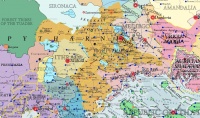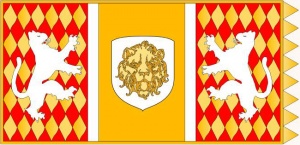Empire of Magdala

The Empire of Magdala is the principal dominion of southeastern Pytharnia. The capital is Trevirs while the residence of the Emperor has been Royal Trevirs since 2613. The Empire of Magdala should be distinguished from the Magdalanate which is the core territory of the empire. Neighboring countries are the Disdrirn Elves, Kasthavia, the Commonwealth of Gdelisica, Viceroyalty of Jagohr, the Aurician Over-Province of Agogia, the Kingdom of Thrain, Medibgóëse Gonfaloy, the Archpatriarchy of Ambrasia, the Commonwealth of the Ithrads, the small gnomish city-state of Bundankel, and to the far northwest, the Forest Tribes of the Tuadbe. The unusual shape of the empire is due to the various principalities which comprise it. Thanks to the Duchy of Ogentir, the empire is not entirely landlocked. None of the other principalities of the Empire of Magdala has access to the sea.
The Empire of Magdala is very populous like much of southern Pytharnia. Trevirs is the most populous city in the West with over one million inhabitants. Caffgara, Paddarvi, Baihorn, Nivernest, Dernuvia, and Ardh Kevas are also very populous with at least 100,000 inhabitants each.
A cool temperate climate is typical for most of Magdala which rests mainly on the Pytharnian Highlands. Light snows once or twice are not uncommon in the high winter. The Duchy of Ogentir enjoys a more moderate climate along the coast where it very rarely snows. Much of northern Magdala is forested as part of the Skelkast Forest. Magdala is regarded by the Disdrirn Elves as a great threat to the old growth forests of central Pytharnia.
Demography
The Empire of Magdala blends many different races and traditions. Most humans are of Moigthe heritage. Gonfalese humans are next most common, followed by Jagohrish pockets in far eastern Magdala. The Tuadbe are the largest non-Gwenyan human element and they are the descendants of the ancient Neptultchi. Humanlikes have significant numbers, especially halflings, quirth, and lizardfolk who enjoy some local autonomy. There are a few dwarven expatriate communities in the larger cities, especially Trevirs. Common giants are present in small numbers, some living in family groups and others visiting from the Disdrire Forest. There are very few elves in Magdala where there are any at all. Most elves are attached to mercantile concerns and diplomatic relations with the empire.
Chartered Cities
Several cities in the Empire of Magdala enjoy autonomy from the local lord and thus are not subject to Principate Law. These are Chartered Cities. They pay an annual tribute to the Throne of Magdala and enjoy special tax benefits. They also send a deputy to the Palace of the Imperial Diet of Magdala.
History
The Kingdom of Magdala gradually arose from the ashes of the Golden Empire of Pytharnia in the fifteenth century, founded by Llawffagain Ontigure. At this time, the monarchy did not have any power over neighboring states as it does today. The queen was a member of the college of Magdisuman Priestessses and the college served as an advisory body to the king. The kingdom continued through the early Middle Ages with two successive dynasties, the Ontigurian and the Obandian. Rhochuveal Oband, the last ruler of Obandian Kings, succumbed to chaos wizards and the throne of the King of Magdala lay vacant amid the rising tide of chaos cultists, particularly the College of the Flamens of the Changeable Gods. During this time, the Magdisuman Priestesses held a low profile, in some regards going into hiding. Lord Kualotha of the Groaning Earth never laid claim to the monarchy, though he held many of the functions of the kingship of Magdala.
Very quickly following the Twelfth Isbajath, the monarchy was re-established by Tirrhaglewb of Medibgö in the Tirrhaglewbian Dynasty. The ties to the Medibgösk monarchy remained through this dynasty until it was supplanted by Smalig Brona. Early in the twenty sixth century, the power of Thrace eclipsed the power of Medibgö and Thracian governors ruled Magdala and Pytharnia through till 2573. Griovain Llyffclaw, leader of the League of Pytharnia, along with the allies, prevailed in the Great Sky War. His son, Medibglame I was accepted as the ruler of the restored monarchy and crowned in 2574. Most of the principal lords chose to become members of the Empire. The core territory of Magdala became named the Magdalanate. House Llyffclaw adopted the white lion as the imperial device.
Government
The government of Magdala consists of the Throne of Magdala, the College of Magdisuman Priestesses, the Imperial Council, and the Imperial Diet. The Emperor holds most power, but is subject to controls by the Imperial Diet. By custom, the emperor typically defers to the wishes of the Imperial Diet where a strong consensus has been reached and he gives great weight to advice given by the College of Magdisuman Priestesses. The Imperial Council consists of the Chancellor of Magdala, the Chamberlain of Magdala, the Grand Master of Magdala (compare Lord High Steward), the Marshal of Magdala, the Mage of Magdala, the Knight of the Empire of Magdala, and the Lord High Governor of the Magdalanate.
Reform Movements
Magdala like other human states in Pytharnia remains resistant to substantive democratic reforms, despite the examples set by the dwarven commonwealths, the Noble Republic of Aurice, and the Republic of Ithatia. In Trevirs and the other largest cities, several reform movements actively seek to increase the participation of the middle and lower classes in the government. Some advocates wish to see Trevirs gain greater autonomy in all local affairs of governance and for the Magdalanate to gain the power to select its own Lord High Governor.
Politics
Magdala shared control of the government of the Viceroyalty of Jagohr with Aurice for many years. The Republic of Ithatia is an important ally with Magdala against the power of Aurice. Magdala is the principle human state with which the reclusive Disdrirn Elves have any regular communications. The sanctity of the forest and a halt to all human encroachment on the Skelkast Forest are the critical issues of the relationship between Magdala and the elves. Magdala continues to hold a special relationship with Medibgö and both states are members of the Union of Pytharnia. Magdala shares a long border with the dwarven state of the Ithrads and has several treaties of mutual defense with the Ithrads. Dwarves from the Ithrads and the Jaggudorns are permitted to travel freely through the empire to their neighbors. The Empire has courted Ambrasia which has staunchly kept its independence. The Empire of Magdala is one of the three member states of the Union of Pytharnia. The main overseas colony of Magdala is Merethaia.
Economy
Magdala is very dependent upon grain shipped from Thrace via the Grand Shadew Canal and from resources provided in her colony of Merethaia. Magdala has a strong tradition of leadership in art and fashion. Magdala is a principle producer of wool and linen. Copper is mined in the Barony of Lionhaven. Cottage industries count for much of the manufactured goods outside of the cities.
Technology
Magdala saw the early development of Dragonrail compared to other human states in Pytharnia. As with the rest of Pytharnia, all dragonrail services are controlled by the Dwarven Dragonrail Guild of Pytharnia. Trevirs has several manufacturing centers for titancraft engines and vessels. The Sovereign Archguild of Master Titancrafters of Pytharnia controls much of
Languages
The main language spoken in the empire is the Pytharnian Language. The second most spoken language is Gonfalese. The official language of the Union of Pytharnia is Medibgóëse. Minority languages include the language of the lizardfolk, Thrainish, Pytharnian Geddamin, Disdrirn Elvish, and the Jagohrish Language, especially in Caffgara.
See Also
- List of Principalities of the Empire of Magdala
- List of the Rulers of Magdala
- Magdalan Aristocratic Ranks
- Principate Law
- Pytharnia
- Royal Trevirs
- Trevirs
| This article is a stub. It requires further development by the creator. |




